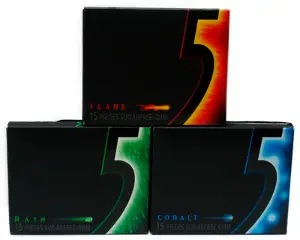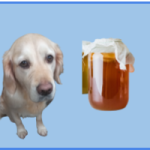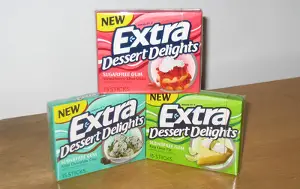
There are a lot of fans of 5 Gum out there, and maybe you’re one of them.
Made by the Wrigley Company, this gum is sugar-free and low in calories.
If you are a fan, you might be wondering about sharing a piece with your dog, but you may be hesitant because you’ve heard that some chewing gum contains xylitol which is known to be dangerous to dogs.
So does 5 Gum have xylitol?
Let’s find out why, and also explore why xylitol is dangerous for our furry friends.
Why is xylitol poisonous to dogs?
Xylitol isn’t poisonous for humans, so why is poisonous for dogs?
The answer lies with blood sugar, and more specifically with the role of insulin in controlling it.
When a dog digests xylitol it absorbs more quickly into their bloodstream than in humans which can result in the pancreas releasing too much insulin at once.
If this happens it can lead to hypoglycemia, and if left untreated this condition can be deadly to dogs.
What are the signs of xylitol poisoning in dogs?
Typically the signs of xylitol poisoning in dogs will occur within a few hours of consumption, and when they begin they will normally be the classic signs of hypoglycemia.
There is a chance your dog could develop liver failure from xylitol poisoning, in which case they may not show signs of hypoglycemia first.
Signs of hypoglycemia in dogs include vomiting, weakness, sluggishness/lethargy, a lack of coordination or difficulty walking/standing, tremors, seizures, or a coma.
If your dog displays any of these symptoms then you should take them to the vet immediately, and if you know your dog has ingested anything containing xylitol then you should take them even if they aren’t displaying symptoms yet.
How much xylitol does it take to poison a dog?
It doesn’t take very much xylitol to cause a negative reaction in a dog, and for this reason any amount ingested is dangerous.
If the amount ingested is fairly small then it’s more likely to cause hypoglycemia, whereas if the amount is larger then it generally causes liver failure.
And it’s also important to keep in mind that the size of the dog is a factor in how much xylitol it takes to become toxic.
Normally the range of xylitol used in gum is between 300 to 1500 mg per piece of gum, and some people say that xylitol becomes toxic if a dog ingests 50 mg per pound of its body weight. This means that one piece of gum could be highly toxic to a 20 pound dog if it contains 1,000 mg or more.
What are the ingredients in 5 Gum?
The ingredients listed on one of the packs of 5 Gum is as follows (you should remember the ingredients might differ slightly depending on flavor):
Sorbitol,
Gum Base,
Glycerol,
Natural and Artificial Flavors;
Less Than 2% of: Hydrogenated Starch Hydrolysate, Aspartame, Mannitol, Acesulfame K, Soy Lecithin, Color (Blue 1 Lake), Bht (To Maintain Freshness)
Allergens & Warnings: PHENYLKETONURICS: Contains PHENYLALANINE.
Now let’s talk about this list.
As you can see, 5 Gum contains no xylitol.
It does however, contain sorbitol. Sorbitol, like xylitol, is also used as a sweetener in sugarless gums, but is actually used more often because it’s less expensive.
Sorbitol is actually not dangerous for your dog to ingest, and the worst it will do in most cases is cause some issues with their digestion.
In what other ways is 5 Gum bad for dogs?
Just because 5 Gum doesn’t have xylitol, it doesn’t mean that is safe for dogs.
In fact, not only 5 Gum, but all chewing gum comes with certain hazards and it isn’t something that you should ever give your dog.
One issue with dogs and chewing gum is that they can’t chew on things long term like us humans can, this means that gum is a major choking hazard for them.
And aside from that, chewing gum is packed full of other artificial sweeteners, sugars, and chemicals that aren’t good for dog’s health in the long term.
What other main artificial sweeteners are used in chewing gum?
One of the main artificial sweeteners that you may run into is aspartame, which isn’t something that you want your dog to have but it isn’t necessarily dangerous to them like xylitol is.
And you may have noticed that aspartame is one of the ingredients in 5 Gum.
Some other notable artificial sweeteners are erythritol, stevia, saccharin, and sucralose.
You may be wondering at this point, why are artificial sweeteners used in the first place instead of sugar.
There are many reason for this, but the mains one are the fact that they don’t contribute to tooth decay.
Additionally they contain almost no calories.
And finally, it takes less artificial sweetener than real sugar to get the same result, so using artificial sweetener is cheaper for manufacturers.
What other things contain artificial sweeteners such as xylitol?
Now that we’ve discussed how toxic xylitol can be for dogs, you’re probably wondering what other products could potentially contain it.
Xylitol can be present in many things, so it always pays off to read the ingredients.
In addition to sugar free gum, xylitol is also commonly used in oral hygiene products such as toothpaste and mouthwash.
Xylitol is also present in quite a few foods: baked goods, peanut butter, drink powders, candy, pudding, condiments (like ketchup and barbecue sauces), and pancake syrups.
And surprisingly xylitol can also be found in certain medications, specifically chewable vitamins and “fastmelts” or “meltaways”.
What are some other ways you can freshen your dog’s breath?
If you were hoping to find out that chewing gum was safe for your dog because your dog suffers from bad breath then you’re probably extremely disappointed right now.
A lot of dog owners can probably relate to trying to freshen their dog’s breath, after all, a lot of us do let our dogs lick us in the face.
And that isn’t the most pleasant thing if your dog has stinky breath.
So.. what are some other ways we can freshen our dog’s breath?
The methods we can use to freshen our dogs breath depends on the cause for the problem.
There are many reasons your dog might have bad breath, and some of those reasons can only be cured by a vet.
The cause behind your dog’s stinky breath could be oral hygiene and periodontal disease, less than optimal eating habits (such as eating feces), liver disease, kidney disease, or diabetes.
Some of the more serious health conditions will require a vet to fix, and periodontal disease and/or plaque build up will require a dental cleaning.
If the bad breath is caused by gross eating habits then you can solve this issue by making sure they can’t reach things like roadkill, litter boxes, and trash.
What are some ways you can prevent bad breath in your pup?
If it’s at all possible we would like to prevent the bad breath in the first place, and there are several ways to do this.
The easiest way is to make sure to brush your dog’s teeth regularly, but you need to make sure to get toothpaste that is made for dogs.
Human toothpaste contains xylitol like we discussed earlier, so it should be avoided.
You can also give your dog chew toys and dental treats that will help prevent plaque and tartar build up by promoting chewing, which does this naturally.
There are also some great dental chews and water additives you could think about introducing to your dog, you can get recommendations from your vet on which ones to choose.
And of course keeping your dog on a good and healthy diet, as well as making sure they exercise properly can help with preventing some of the more serious health conditions that can cause bad breath.
Key Takeaways
The takeaway for this article should be that although 5 Gum specifically doesn’t contain xylitol it does present other potential health issues for your dog and it probably isn’t a dog friendly treat.
The same can be said for all gum, sugar free or no.
Either they contain xylitol or are simply choking hazards.
As far as xylitol goes, you should be careful that your dog never ingests something that contains it, and if your dog does get ahold of something containing xylitol then you should take your furry friend straight to the vet.
And as always, give yourself a pat on the back for being the kind of pet parent that learns about what is good and what isn’t good for your dog.





